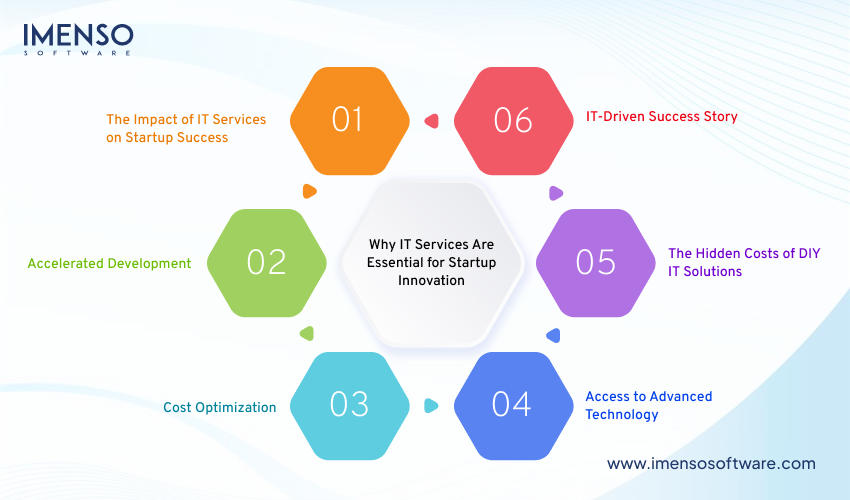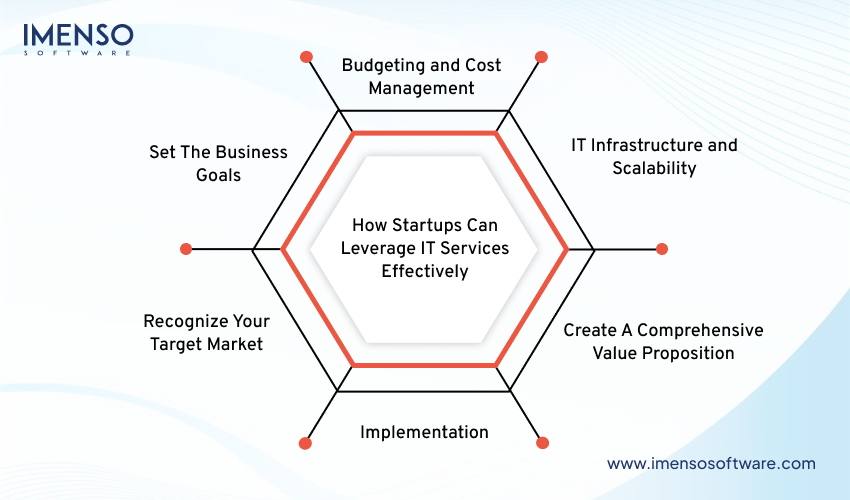How IT Services Can Help Startups Innovate Faster

Is your startup grappling with operational challenges as it scales? Communication breakdowns and data management issues can impede innovation and growth. Project delays are also a significant obstacle to growth. According to FinancesOnline, 40% of executives site upgraded operational efficiency as the top advantage of digital transformation. Strategic IT services can help startups overcome challenges. Startups can fully benefit from digital transformation. This includes improved efficiency and faster innovation.
IT services offer a critical edge in this landscape. They help startups streamline processes, accelerate development, and stay ahead in their industry. Startups can unlock innovation faster than ever imagined. They can do this by leveraging cloud-based solutions or outsourcing niche expertise.
This blog explores IT services and their role in innovation. It also explains how startups can leverage these services to scale their businesses more effectively.
What IT Services Can Do for Startups
IT services encompass a broad range of solutions designed to optimize a startup’s tech ecosystem. These services offer agility for startups. They also ensure a robust technological backbone.
Key areas where IT services can help
Infrastructure Scaling: Cloud platforms like AWS and Azure allow startups to scale resources. Startups can scale resources on demand. These platforms eliminate the need for hefty upfront hardware investments.
Custom Development: IT teams create tailored solutions for unique challenges. These solutions can include platforms designed to streamline operations or enhance customer experiences.
Security & Compliance: Startups often overlook the Power BI cybersecurity dashboard in the rush to scale. IT services help implement policies and tools to safeguard sensitive data and comply with regulations.
Integration of Tools: Startups rely on multiple SaaS tools, but disjointed systems can slow innovation. IT services integrate these tools for seamless workflows.
Example: A health tech startup can expand its telemedicine services. They can leverage IT consultants to integrate HIPAA-compliant video platforms. This integration reduces time-to-market.
Why IT Services Are Essential for Startup Innovation

Startups face unique challenges: lean teams, limited resources, and tight deadlines. IT services bridge the gap between ambition and execution. They offer tailored solutions that drive innovation, efficiency, and growth.
The Impact of IT Services on Startup Success
IT services help startups reduce the time to market. They offer the tools and excellence for fast prototyping and feature deployment. This allows startups to modernize faster, reduce costs, and stay competitive in a rapidly changing market. Look at some key points:
Accelerated Development
IT services help startups reduce the time it takes to turn ideas into reality by providing the tools and expertise needed for rapid prototyping and feature deployment. This ensures startups can meet market demands quickly and maintain a competitive edge.
Cost Optimization
By using IT services, startups can avoid the high investments of hiring and maintaining a full in-house team. They can access specialized skills and resources as needed. This allows them to optimize their budget without compromising on quality or innovation.
Access to Advanced Technology
IT services help startups reduce the time it takes to turn thoughts into truth by using providing the tools and understanding wanted for fast prototyping and characteristic deployment. This guarantees startups can meet market demands quickly and hold a competitive part.
The Hidden Costs of DIY IT Solutions
Solutions are significant for startups. Attempting to handle IT internally often leads to inefficiencies and system downtime. This, in turn, disrupts operations and hinders growth. Limited resources and expertise can hinder effective problem-solving. This is because they make it difficult to address critical technical challenges.
A health-tech startup managing cybersecurity on its own might overlook vulnerabilities. This could expose sensitive data to breaches. Such incidents can damage trust, reputation, and future business opportunities.
IT-Driven Success Story
The education sector is seeing key SaaS trends revolutionize student engagement. These trends use AI-powered analytics to achieve this. IT consultants are partnering with these trends to achieve this. The startup used advanced data insights to understand user behavior and preferences. This understanding helped streamline product development.
This collaboration resulted in a 25% faster development cycle, allowing the team to launch features quickly and efficiently. The improved user experience also led to higher adoption rates, driving growth and customer satisfaction.
How Startups Can Leverage IT Services Effectively

According to the latest survey, over 80% of startup leaders think that innovation is important to their company’s fulfillment. Less than 10% of them, although, had been secret to the correct troubles with their product and their plans to cope with them. Developing a product innovation strategy clarifies the direction of software product development. It defines the stages of the development process.
Innovation strategy is exactly the product’s specific plan designed to give customers value. The entire team, at all levels, must participate in the complex process of innovation. You can plan the next stages of your product’s progression. Develop a solid product innovation strategy to achieve this.
Consider the following important considerations while creating your innovation plan.
Set The Business Goals
When setting business goals, think about what you want to achieve and why it’s important. Clear goals give your team direction and motivation. Begin by requesting questions such as, “What issues do we want to solve with this product?” and “How will this product help our customers?” Clearly define your goals. Examples include increasing sales, improving customer satisfaction, or standing out from competitors.
Once the “why” is clear, break down big goals into smaller steps. For example, if your goal is to grow your user base, one step could be creating features that make your product easy to use. Another might be marketing your product to the right audience.
Finally, make sure your goals are realistic and measurable. This way, you can track your progress and adjust your plans if needed. Clear goals keep everyone focused and help you turn ideas into success.
Recognize Your Target Market
Recognizing your target market is the first step towards creating a product that without a doubt stands proud. Start by using the know-how of who your clients are—what they need, what problems they face, and what solutions they need. Equally essential is keeping an eye on your competition. Look at the functions they provide, how they market their products, and what customers like about them. This enables you to see opportunities to make your product better.
When you focus on your target market, you can adapt your product to meet their needs more effectively.
For Example, Your competitors may offer basic features. To make your product more appealing, add something unique. This doesn’t just keep your existing customers happy—it attracts new ones, too. Monitoring the competition gives you ideas to stay ahead. This helps ensure your product always provides better value. This approach turns your product into a solution customers can’t resist.
Create A Comprehensive Value Proposition
Creating a strong value proposition is like finding the unique spark that makes your product special. It helps you clearly define why customers should choose your product over others. A well-crafted value proposition guides product development and marketing efforts. It serves as a guiding light for your product.
A clean value proposition indicates how your product solves trouble or fulfills a want higher than competitors. It highlights the important capabilities and benefits that make your product stand out. For example, if your product saves time or makes life easier, emphasize that in simple terms.
To craft a great value proposition, focus on your target audience. Understand their pain points and what they truly care about. Keep the message straightforward and specific so customers can quickly see the value.
Remember, a strong value proposition not only attracts customers but also keeps them coming back for more.
Implementation
Once your product innovation plan is ready, the next step is careful implementation. This often involves assembling the right team. This team may include hiring developers with expertise in specific technologies. Breaking the implementation into phases ensures smooth progress. These phases include research, development, testing, launch, and performance measurement. Each phase should have clear goals and deadlines to keep the team on track.
- During the research phase, gather detailed insights into your market and customers’ needs. This step will guide the development of features that users will truly value.
- In the development phase, focus on building a reliable product while keeping user experience in mind. Use agile methods to adapt quickly to any challenges.
- The testing phase is critical to catch bugs and make improvements before launch. User feedback here can be a game-changer.
- During the launch and measurement phase, ensure a smooth transition for your current customers. Focus on making the transition as seamless as possible. Provide tutorials and support to avoid confusion and disruptions.
With these steps, your innovation will create lasting value for users.
IT Infrastructure and Scalability
Planning is the bedrock of a successful startup’s digital presence. It’s about building a technological foundation that not only meets current needs but also supports future growth. A robust IT Services infrastructure ensures smooth operations and seamless scaling as your business expands.
A key decision is choosing between Cloud vs. On-Premise solutions. Cloud services (AWS, Azure, GCP) offer flexibility and scalability. These services allow resource adjustments as needed. On-premise infrastructure provides more control but requires greater upfront investment. The choice depends on cost, scalability needs, and security priorities.
Equally crucial is Scalability and Security. Designing systems to handle increasing user loads and data volumes is essential for long-term success. Robust security measures are essential for IT planning. These measures should protect data, prevent cyberattacks, and maintain customer trust. Prioritizing these elements builds a resilient and trustworthy digital foundation.
Budgeting and Cost Management
According to a survey by Flexera, companies waste an average of 30% of their cloud spending because of lacking useful resource control. It is essential for startups using IT services, which often consume a large portion of their budget. Careful financial planning ensures maximum value from IT investments.
Accurate cost estimation is the first step. This involves predicting expenses for hardware, software licenses, cloud subscriptions, and IT staff salaries. Accurate estimates inform smart spending decisions.
Next is cost optimization, finding ways to reduce expenses without compromising quality. This involves negotiating with vendors. It includes using open-source software. Careful cloud usage management helps avoid unnecessary costs.
Finally, it’s important to establish the return on investment (ROI) of IT tasks. This means determining if technology spending is beneficial. This sentence assesses whether spending on technology leads to positive outcomes. These outcomes include increased efficiency, higher sales, or improved customer satisfaction. This data-driven approach ensures IT investments contribute to the startup’s growth. This approach helps the startup achieve success.
Adopting offshore software development can further optimize IT spending by providing access to skilled talent at competitive costs. This strategy ensures startups achieve high-quality solutions while maintaining a strong focus on ROI and sustainable growth.
Also Read:-
The Role of IT Services in Building Resilient Startup Ecosystems
What Are NFTs? And Whether Your Business Should Care?
How to Create your own Instant Messaging App like WhatsApp with 100% Privacy
Final Thought
Once your business is set up, it’s normal to pause and admire your achievements. Today’s rapidly evolving IT Services and technological landscape makes relying completely on past successes unsustainable. A constant alternative needs a proactive method of innovation. Keeping open thoughts and embracing new thoughts is essential for long-term growth.
Periodic innovation is essential for reaping future rewards. Your current product strategy is effective now. However, technological advancements and shifting market dynamics can quickly make it obsolete. Adapting and evolving are not optional but necessary for continued success.
Therefore, embracing a culture of continuous innovation is paramount. Ready to future-proof your business? Contact Imenso Software today. Our expert team can help you navigate technological complexities. They can drive your business forward in this ever-changing world.
Don’t just take our word for it—see what our clients are saying about us on Clutch.
Frequently Asked Questions
What is the meaning of faster innovation?
Faster innovation leads to accelerating the process of turning ideas into real-world results. It considers using advanced technologies, agile methods, and a culture of constant experimentation to less development cycles.
Why innovation is important in startup growth?
Innovation drives startup growth by unlocking new opportunities and creating unique value. It helps startups differentiate themselves in competitive markets and address unmet customer needs effectively.
How AI is helping startups?
Artificial intelligence is revolutionizing startups by automating monotonous obligations, and saving time and resources. Tools powered via AI streamline operations, boost customer support with chatbots, and offer predictive analytics for a smarter ability to plan.
What is the role of technology in the growth and promotion of startups?
Technology drives startup growth by streamlining operations, automating processes, and enabling scalability. Tools like cloud computing and CRM systems help startups expand without heavy upfront investments, while data analytics provides insights for strategic decision-making.
For promotion, digital platforms and AI-powered marketing tools amplify outreach, connecting startups with their target audience. Social media, SEO, and customized campaigns make certain startups compete correctly, constructing a robust logo presence and fostering rapid growth.
How can startups use AI and technology to drive faster innovation and achieve sustainable growth?
Startups can use AI to automate methods, advantages of actionable insights, and make data-driven decisions faster. AI tools such as machine learning and predictive analytics allow startups to optimize operations, increase customer experiences, and predict market trends.
Want more information about our services?
Similar Posts

Developing Cross-Platform Mobile Apps with React Native and Its Advantages
In the rapidly evolving world of mobile app development, the need to deliver seamless user experiences across different platforms is paramount. Building separate native apps for iOS and Android can be time-consuming, costly, and resource-intensive. Enter React Native, a powerful framework that offers a solution to this problem. In this blog, we will explore the […]...

Continuous Integration and Continuous Deployment: A Guide for Modern Enterprises
Are you aware that an organization with automatic CI/CD pipelines deploys more code up to 200 times than one that has nothing to do with these activities? The rate of evolution in the world of business today is outrageous. If slow software delivery is accompanied by low standards, it can be disastrous. Developers need to […]...

Top Reasons Why ReactJS Is the Most Preferred Platform for Web App Development
Are you looking to build a powerful, user-friendly web application that will take your business to the next level? Look no further than React JS! As one of the most popular and versatile platforms for web app development, ReactJS development offers countless benefits for businesses of all sizes, from increased efficiency and scalability to seamless […]...









